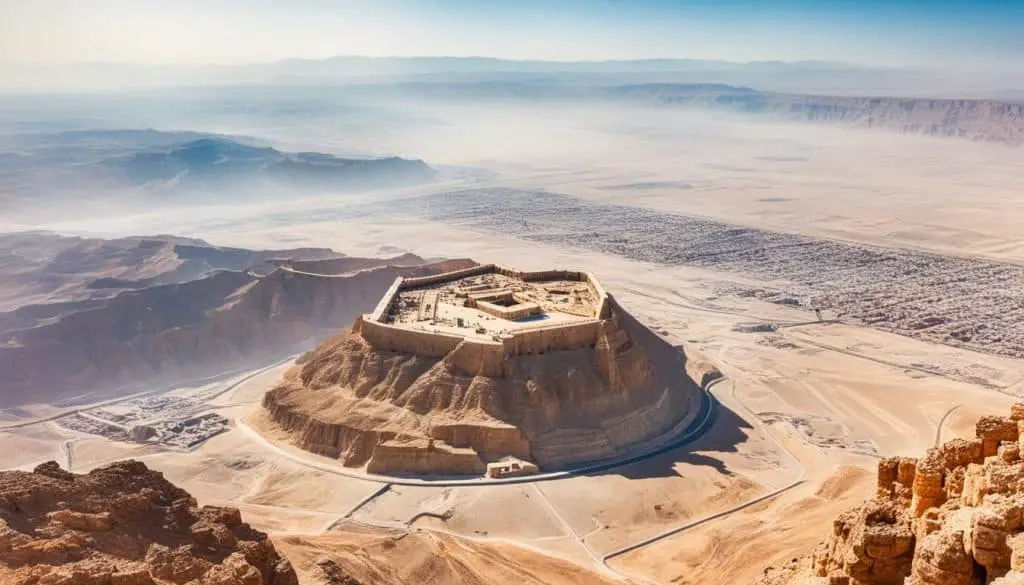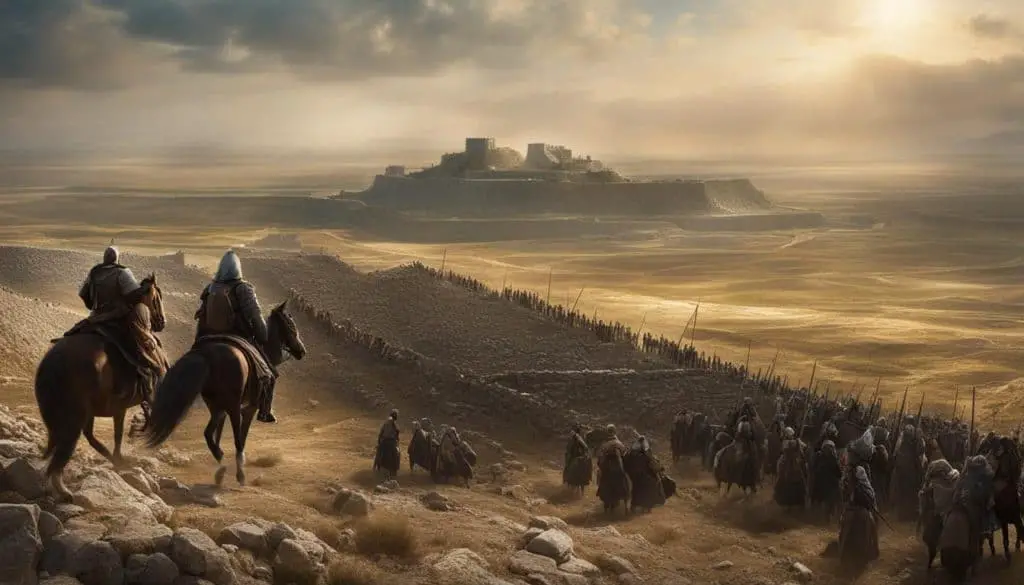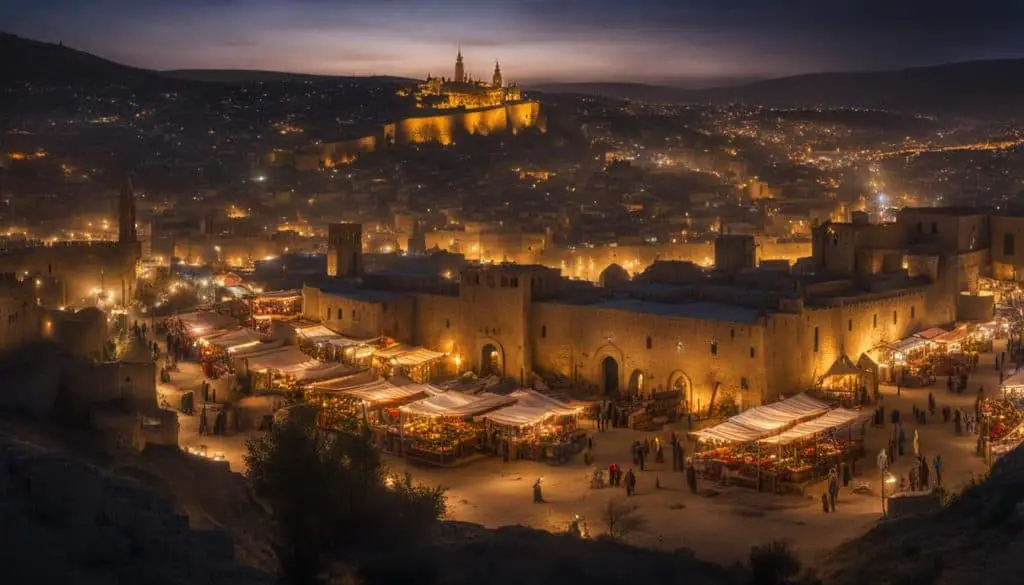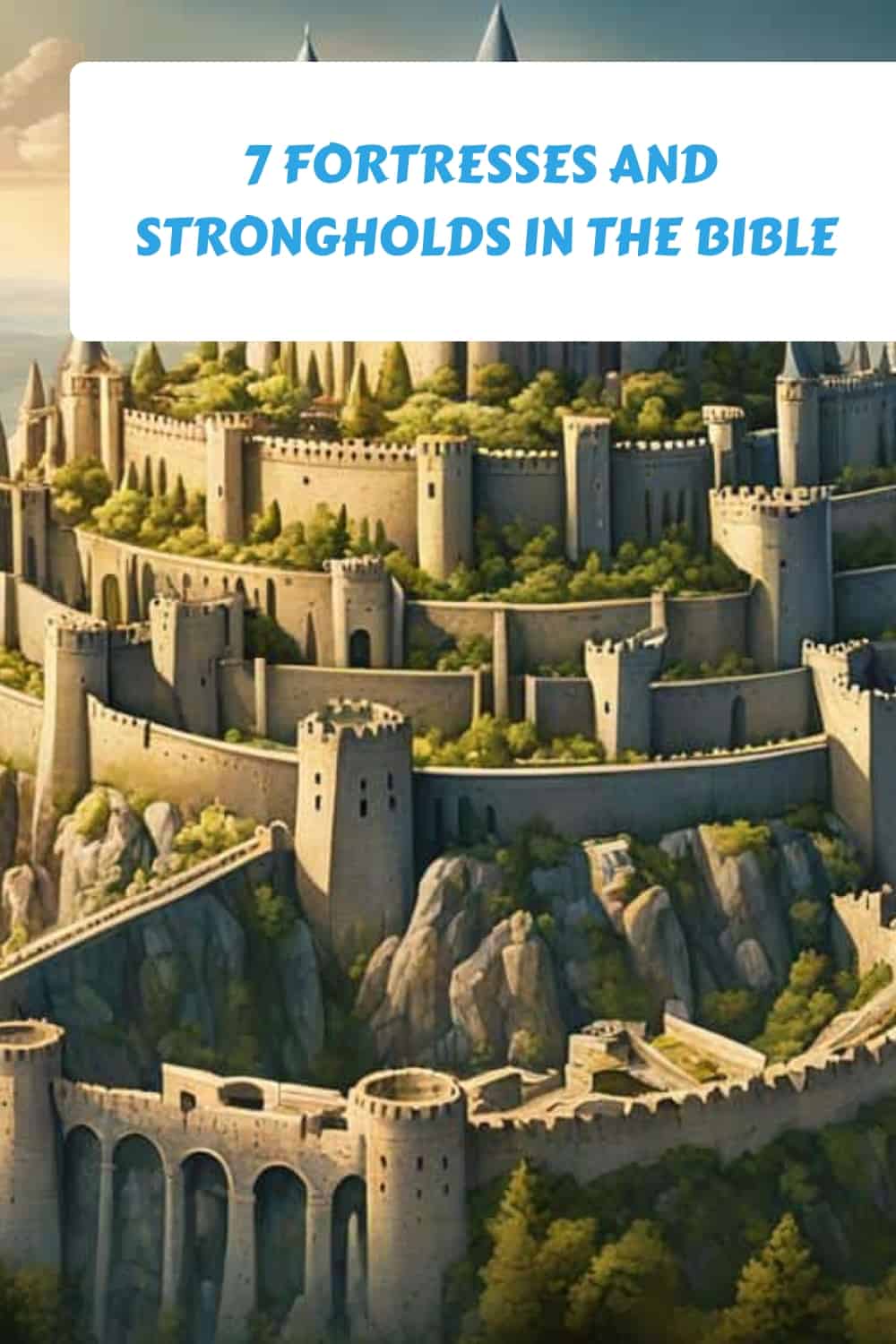Table of Contents
Have you ever wondered what it would be like to stand atop the walls of an ancient fortress, gazing out at the world below?
Or how it felt to seek refuge in a stronghold, knowing it would protect you from any threat?
The Bible is filled with stories of towering fortresses and impenetrable strongholds that captured the imagination of believers for centuries.
Join us on a journey through time and discover seven awe-inspiring fortresses and strongholds that played key roles in biblical history. From Jericho’s fallen walls to the mountainous refuge of Masada, each location has its own unique stories and historical significance.
So, are you ready to delve into the world of biblical fortresses and strongholds? Let’s embark on this adventure together and unlock the secrets of these remarkable structures.
Jericho – The City with Walls that Went “Crash!”
Jericho, a prominent city in the biblical era, is renowned for its mighty walls that famously came tumbling down. According to the Bible, the Israelite leader Joshua and his crew marched around the city for seven days, blowing trumpets on the seventh, causing the walls to collapse.
This captivating story of Jericho showcases the power of faith and the triumph of the underdog.
Despite the seemingly insurmountable barriers presented by the robust walls of Jericho, the unwavering belief in a higher power and the strategic obedience to divine instructions resulted in an astonishing victory.
“By faith the walls of Jericho fell, after the army had marched around them for seven days.” – Hebrews 11:30
This remarkable event not only demonstrates the historical significance of Jericho but also serves as a powerful symbol of courage, resilience, and the potential for overcoming formidable challenges through unwavering faith.
The image above depicts an artist’s rendition of the walls of Jericho, highlighting their formidable size and historical significance.
Masada – The Mountain Fortress with a View
Masada, situated on a rocky hill in the desert, served as King Herod’s hideout and later became the last stand for a group of rebels. With its breathtaking panoramic view and impressive architectural features, Masada is a testament to ingenuity in the face of adversity.
“Masada stands as a symbol of human determination and the pursuit of freedom. It was a fortress that provided refuge and security, but also witnessed the tragic end of a rebellion,”
Perched atop a towering plateau overlooking the Dead Sea, Masada boasts spectacular views of the surrounding Judean Desert. The strategic location made it an ideal stronghold and a symbol of power during ancient times.

King Herod, known for his grand architectural projects, chose Masada as one of his lavish retreats. Under his rule, the fortress was expanded and fortified, showcasing Herod’s opulence and engineering prowess.
However, Masada gained even greater historical significance during the Jewish-Roman conflict. In 66 CE, a group of Jewish rebels seeking refuge from Roman oppression, took control of Masada. Led by Eleazar ben Ya’ir, these rebels held out against the Roman forces for three long years.
“We have not been conquered by surprise, but have succumbed after a struggle. Nor is our end inglorious…Let our wives die before they are abused, and our children before they have tasted slavery.”
When the Romans finally breached the fortress walls in 73 CE, they found that the rebels had chosen death over surrender. According to historian Josephus Flavius, only a few survivors were left to tell the tale.
Today, Masada stands as a symbol of resilience and endurance. Its story of defiance and sacrifice continues to inspire visitors from around the world.
The City of David – Where Kings Roamed
The City of David, located in the heart of Jerusalem, is a significant biblical site that holds a pivotal role in the history of Israel. It was here that King David established his kingdom, making it the original capital of Israel.
At the City of David, visitors can explore the remains of ancient structures that date back thousands of years, offering a glimpse into a bygone era. One of the notable attractions is the majestic palace, believed to be the residence of King David himself. This grand structure serves as a testament to the power and influence of one of Israel’s greatest kings.
Adjacent to the palace stands a mighty fortress, strategically positioned to protect the city from potential invasions. This fortified structure exemplifies the military prowess of King David and his successors, as they sought to defend their kingdom from external threats.
The City of David also holds religious significance, as it is believed to be the site where King Solomon constructed the First Temple, one of the holiest places in Judaism. This sacred temple played a central role in the religious and cultural life of the Israelites.
Visitors to the City of David can embark on guided tours, exploring underground tunnels and ancient water systems that were crucial for the city’s survival. These tunnels, known as Hezekiah’s Tunnel, provided an ingenious water supply during times of siege, allowing the inhabitants to withstand prolonged attacks.
“The City of David is a captivating destination that transports you back in time. It not only offers a glimpse into the lives of biblical kings but also provides valuable insights into the broader history and culture of ancient Israel.” – Archaeologist Sarah Cohen
For history enthusiasts and those seeking to connect with their biblical roots, a visit to the City of David is a must. Witness the remnants of a once-thriving civilization, delve into intriguing archaeological discoveries, and gain a deeper understanding of the legacy left by King David and his successors.
Top Attractions at the City of David:
- The King David Palace
- The Stronghold Fortress
- Hezekiah’s Tunnel
- The First Temple
| City of David Facts | |
|---|---|
| Location | Jerusalem |
| Historical Significance | Original capital of Israel, residence of King David |
| Main Attractions | King David Palace, Stronghold Fortress, Hezekiah’s Tunnel, First Temple |
| Guided Tours | Available to explore underground tunnels and ancient water systems |
Megiddo – The Battlefield of Ages
Megiddo, often referred to as the site of the future Battle of Armageddon, holds a significant place on the ancient battlefield map. Throughout history, countless conflicts and epic tales have unfolded within its borders, making it one of the most notable biblical locations.
Located in modern-day Israel, Megiddo’s historical significance is intertwined with stories of chariot races, palace intrigue, and soldiers clashing on the fields of battle. The remnants of this ancient city stand as a testament to the struggles and triumphs of civilizations long gone.
“Megiddo is the meeting place of warriors, where legends are forged in the crucible of war.”
The Battle of Armageddon, prophesied to take place at Megiddo in the future, has captured the imagination of many. This legendary battle, described in the book of Revelation, signifies the ultimate conflict between good and evil.
As you stand on the hallowed ground of Megiddo, you can’t help but imagine the echoes of the past— the thundering hooves of charging horses, the clash of swords, and the bravery of warriors. This ancient battlefield truly transports you to a different era, where history comes alive before your eyes.
Archaeological Discoveries at Megiddo
The excavation efforts at Megiddo have unearthed fascinating relics that offer a glimpse into the ancient world. Archaeologists have discovered traces of well-preserved buildings, intricate carvings, and luxurious artifacts.
One remarkable find is the Megiddo Ivories, a collection of intricately carved ivory artifacts dating back to the 13th century BCE. These exquisite pieces depict scenes of chariots, battle scenes, and mythical creatures, providing valuable insights into the artistry and craftsmanship of the time.
The Megiddo Stables, a complex structure built to house warhorses, highlight the military importance of Megiddo. These stables could accommodate over 450 horses, serving as a testament to the strategic significance of Megiddo as a military stronghold in the ancient world.

| Key Facts about Megiddo | |
|---|---|
| Location | Modern-day Israel |
| Historical Significance | Major ancient battlefield, site of the future Battle of Armageddon |
| Archaeological Discoveries | Megiddo Ivories, Megiddo Stables, impressive architectural ruins |
| Notable Stories | Tales of chariot races, battles, and prophecy |
Bethlehem – More Than Just a Nativity Scene
Bethlehem, renowned as the birthplace of Jesus, holds a captivating history that extends far beyond its association with the famous nativity scene. This fortified city has witnessed the birth of kings and serves as the backdrop for tales of loyalty and love.
One significant story originating from Bethlehem is the tale of Ruth and Boaz. Ruth, a Moabite widow, found herself in Bethlehem and caught the attention of Boaz, a wealthy landowner.
Their love story unfolds amidst the barley fields, where Boaz acts as a kinsman-redeemer, marrying Ruth and ensuring her welfare. Their union plays a pivotal role in biblical history, as Ruth becomes the great-grandmother of King David, linking her story to the lineage of Jesus.
“And Ruth said, ‘Entreat me not to leave thee, or to return from following after thee: for whither thou goest, I will go; and where thou lodgest, I will lodge: thy people shall be my people, and thy God my God.'”
The narrative of Ruth and Boaz illustrates the timeless themes of loyalty, devotion, and the power of love prevailing against all odds. It showcases how ordinary individuals, in seemingly humble places like Bethlehem, can contribute to shaping monumental events in history.
The Fortifications of Bethlehem
Bethlehem, as a fortified city, played a vital role in protecting its inhabitants from external threats. The strategic location made it a crucial stronghold for various powers throughout history.
- During the reign of King Rehoboam, Bethlehem was fortified, highlighting its significance as a defensive bastion against potential invasions.
- The city walls provided security to its residents, fostering a sense of community and safeguarding them against hostile forces.
- Notably, the walls of Bethlehem symbolize the city’s resilience and determination to protect its rich heritage and profound religious significance.
Explore Bethlehem’s fascinating history and the enduring stories that unfolded within its fortified walls. Beyond the nativity scene, Bethlehem stands as a testament to the intertwining pathways of faith, love, and destiny.

| Key Facts about Bethlehem | |
|---|---|
| Location | Judean Hills, West Bank, Palestine |
| Significance | Birthplace of Jesus, ancestral home of King David |
| Historical Events |
|
What is the historical significance of fortresses and palaces in the Bible?
In the Bible, significant palaces of biblical rulers like King Solomon’s Palace and Herod’s Palace hold historical significance. These fortresses and palaces were not only symbols of power and wealth but also played a pivotal role in shaping the events and narratives of the Bible, reflecting the political and cultural landscape of ancient times.
The Walls of Jerusalem – The Ultimate Stronghold
The Walls of Jerusalem stand as a testament to the city’s enduring strength and resilience throughout history. These ancient stone walls have witnessed countless invasions and served as a safeguard for the city’s inhabitants.
Throughout the ages, Jerusalem has been coveted by numerous conquerors and empires. The walls have stood firm, protecting the city and its people from external threats. From Babylonian invasions to Roman sieges, the Walls of Jerusalem have held their ground, symbolizing the indomitable spirit of its inhabitants.
Not only did the walls provide physical protection, but they also held great symbolic significance. Kings and rulers sought to fortify Jerusalem, investing resources and manpower to strengthen the walls.
The walls represented the power and authority of the kingdom, as well as its commitment to the defense of its people.
Today, the Walls of Jerusalem continue to inspire awe and admiration. They serve as a reminder of the city’s rich history, the resilience of its people, and the importance of protecting cherished heritage.
The walls are a testament to the determination of those who built and defended them, making them the ultimate stronghold.






